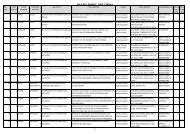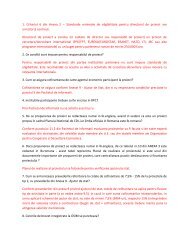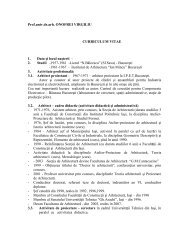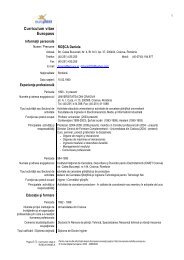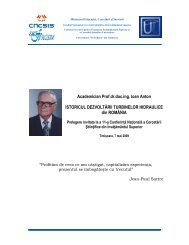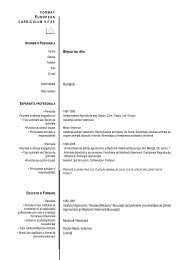Modul de formare-Managementul resurselor financiare - uefiscdi
Modul de formare-Managementul resurselor financiare - uefiscdi
Modul de formare-Managementul resurselor financiare - uefiscdi
- No tags were found...
You also want an ePaper? Increase the reach of your titles
YUMPU automatically turns print PDFs into web optimized ePapers that Google loves.
allocated to higher education. At the national level, the education as a national priority is<br />
granted by the allocation of a certain percentage of gross domestic product (GDP). Established<br />
within a limit of <strong>de</strong>cency (6%), this percentage is far from being satisfactory for Romanian<br />
education system in or<strong>de</strong>r to meet the qualitative challenges of the European education system.<br />
The financial autonomy should not be viewed as an itself purpose, but as a reaction of the<br />
universities in the process of adaptation to the global funding system. The global funding is, in<br />
this context, a major challenge.<br />
1.2. The reconsi<strong>de</strong>ration of the higher education funding at international level<br />
Until three <strong>de</strong>ca<strong>de</strong>s ago the higher education institutions have been permanently financed<br />
primarily, from public funds, as their main goal was to form an elite group capable of governing<br />
the state. This was noticeable, especially in the European countries that have adopted the<br />
Napoleonic university mo<strong>de</strong>l 3 . The state has agreed to fund the universities because they were in<br />
his service, satisfying its needs for highly qualified staff. In addition, the cost of higher<br />
education system was relatively low, not constituting a bur<strong>de</strong>n on the public budget.<br />
The <strong>de</strong>velopment of higher education worldwi<strong>de</strong> during the last three <strong>de</strong>ca<strong>de</strong>s has modified the<br />
main role of the universities, turning them into institutions more oriented towards satisfaction of<br />
the productive and social system. Therefore, the state stops being the main beneficiary of the<br />
public service for higher education and, as such, it is increasingly less willing to fund the higher<br />
education alone.<br />
The recent trends in the higher education funding are associated with the change of the<br />
perception on the role of the higher education. The basic characteristics of the higher education<br />
such as "free right", "public good", "social investment", are ignored entirely, the state's role in<br />
the higher education being highly <strong>de</strong>bated 4 . As such, the neo-liberal economic reforms launched<br />
in the <strong>de</strong>veloped and in transition countries led to a collapse of public funding for the higher<br />
education.<br />
On the background of a downward trend of the public expenditures on the higher education and<br />
a growing number of stu<strong>de</strong>nts enrolled in this form of education, the need for financing the<br />
higher education is amplified. However, the reduction of the public expenditures, the budgetary<br />
constraints, raises the question of allocating the a<strong>de</strong>quate financial resources to promote a<br />
performant higher education system.<br />
Unfortunately, there is an educational risk the investment in the education is facing. The<br />
individual can not be sure about the successful graduation of his studies or on future wage<br />
income after graduation. In fact, the results of the education are very different, because there are<br />
stu<strong>de</strong>nts that are not completing their studies, the differences in wage income after graduation<br />
are high and there is even a risk that the graduates, after completing their studies, to not be<br />
employed.<br />
The public loans to the stu<strong>de</strong>nts, which must be returned, do not change the nature of the<br />
educational risk. The risk of investment in education of an individual is a significant problem<br />
because he can not be insured against these types of risks on the private market.<br />
As such, at national level it is very important to <strong>de</strong>termine which is the average income of all<br />
the university graduates. The state must invest in the higher education system to the level where<br />
the average marginal revenue from the educational investment equals the marginal costs of their<br />
3 Miroiu A., Dincă G (2000), Asupra unor probleme privind finanţarea globală a universităţilor, Fundaţia<br />
Coloana Infinitului, pg. 11.<br />
4 Jandhyala B., Tilak G. (2005), Global Trends in the Funding of Higher Education, International Association of<br />
Universities Horizons, World Higher Education News, Vol. 11, nr. 1, pg.1.<br />
7



